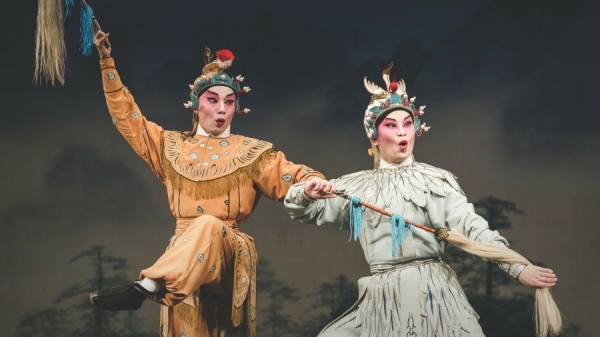
Curtain Call: Preserving Cantonese opera is an uphill task
Hong Kong is fighting an uphill battle to preserve one of its traditional art forms, Cantonese opera.
Shrill music fills the Lyric Theatre in Wan Chai on a Monday night as theatre-goers settle in for an evening of singing, acrobatics and acting. Moments earlier, the small gathering of elderly women and a sprinkling of men had turned the Lyric Theatre’s foyer into a hive of activity. Excited chatter filled the air as groups caught up with old friends, sipped on wine and perused the programme for that evening’s show, Prime Minister of Six States/Excerpts from the Paichangxi Repertoires of Cantonese Opera.
However, by the time the first ear-splitting musical note signalled the start of the opera, the crowd had barely managed to fill half of the 1,181-seat theatre.
In many ways, this scene is representative of the current state of Cantonese opera, a performance art propped up by a passionate but relatively small – and ageing – audience. How much longer, many wonder, can it survive?
On average, at least four Cantonese operas are reportedly staged in Hong Kong every day. UNESCO gave the art form “intangible cultural heritage” status in 2009, indicating that it should be protected and preserved.
In the early days, Cantonese opera was performed in temples or in bamboo sheds used as makeshift theatres. At the start of British rule in Hong Kong, street shows of Cantonese operas were typically held in these bamboo sheds, but the number of Cantonese operas held in the structures had dwindled from 158 in 1970 to 34 by 2010.
To get to the roots of Cantonese opera you need to go back even further to the reign of Emperor Jiajing (1522-1566) of the Ming Dynasty. The art form is a mixture of Yiyang and Kun tunes of the Ming Dynasty; the Xiqin and Han opera of the early Qing Dynasty; regional operas from the provinces of Jiangsu, Henan, Anhui, Hunan, Hebei and Guangxi; and local Guangdong music.
Another recent production, The White Silk Gown (new edition), was held at the new wing of Ko Shan Theatre in Hung Hom, and featured Yu Jiulin as the 20-year-old scholar Xu Jizu. Like many performers, Jiulin discovered Cantonese opera at a young age.
“I was born in Kunshan, where Kunqu originated,” he says, referring to the oldest form of Chinese opera. “Kunqu instructors held an audition at school and they picked me. I was still young at that time – only 16 years old.” His case is atypical. Tales of Chinese legend told through song, dance and elaborate costumes just don’t seem to resonate with audiences under 30 anymore. It’s one of the main reasons why people like Dr Dorothy Ng Fung-ping are pushing to expose Cantonese opera to children in an attempt to spark an interest early on.
In 2007, the University of Hong Kong started a programme to incorporate Cantonese opera into primary and secondary school curriculums. The project was spearheaded by Ng Fung-ping, who at the time was an assistant professor at the Faculty of Education.
Ng Fung-ping and her team trained teachers on how to integrate Cantonese opera into the curriculum, developed teaching materials and introduced students to texts and performances.
To date, more than 50 schools have incorporated the programme. The spread of Cantonese opera to new audiences will soon stretch beyond the classroom with the construction of the West Kowloon Cultural District. Situated on 40 hectares of reclaimed land on the harbour front, the arts hub will feature the Xiqu Centre, one of three major performing arts venues planned for the cultural district.
But even with the construction of world-class venues to host Cantonese operas, if younger generations only watch the performances and don’t actively participate in them, there’s still a real danger that opera could shrink from public view.
“My concern is how Hong Kong educates and develops top-class artists, because the top practitioners of Cantonese opera are getting old and some have passed on,” says Ng Fung-ping. “Even if we have the audience and the venues, if we do not have the right mechanisms to produce top-level performers, then we have a problem.”
Convincing children and young adults to step up and start performing could be tricky, though. Performers undergo specialist training to make sure they can do the unique gestures and singing styles that characterise Cantonese opera.
For many performers, this requires years of study in the mainland and Hong Kong, and some even take a degree course – the first of its kind in the world – at the Hong Kong Academy of Performing Arts. Once performers have completed their training, the hard work is just beginning, as some operas can take years to go from planning phases to the stage.
For instance, it took three years of preparation to put on stage The White Silk Gown. Indeed, the movements of every cast member have to be carefully plotted and perfected, culminating in a performance that has been years in the making. When the opera draws to a close the audience slowly files out and once again the foyer is filled with chatter before people head home to share their experience with family members who might not turn away from the TV to listen.
Text: Andrew Scott










